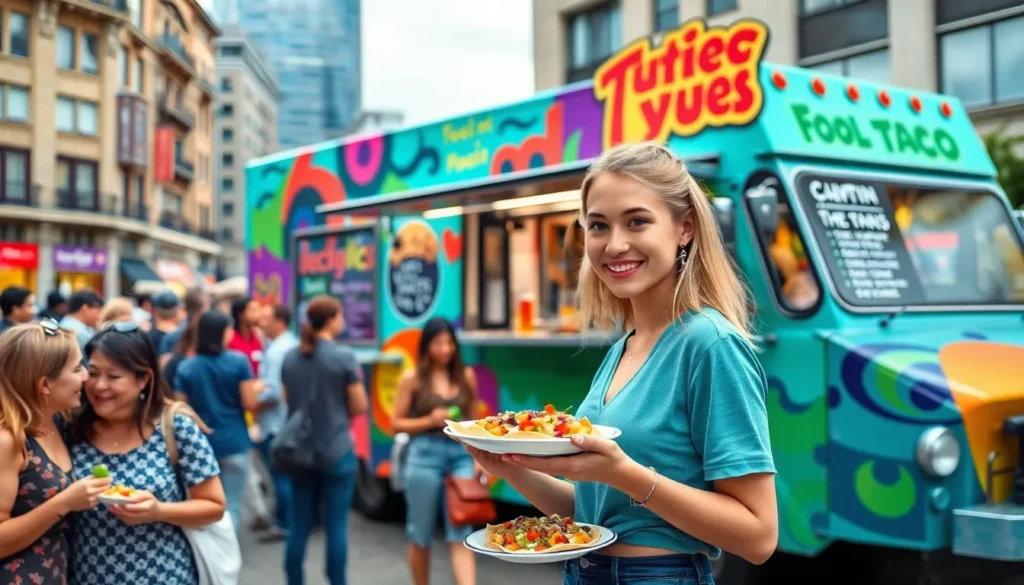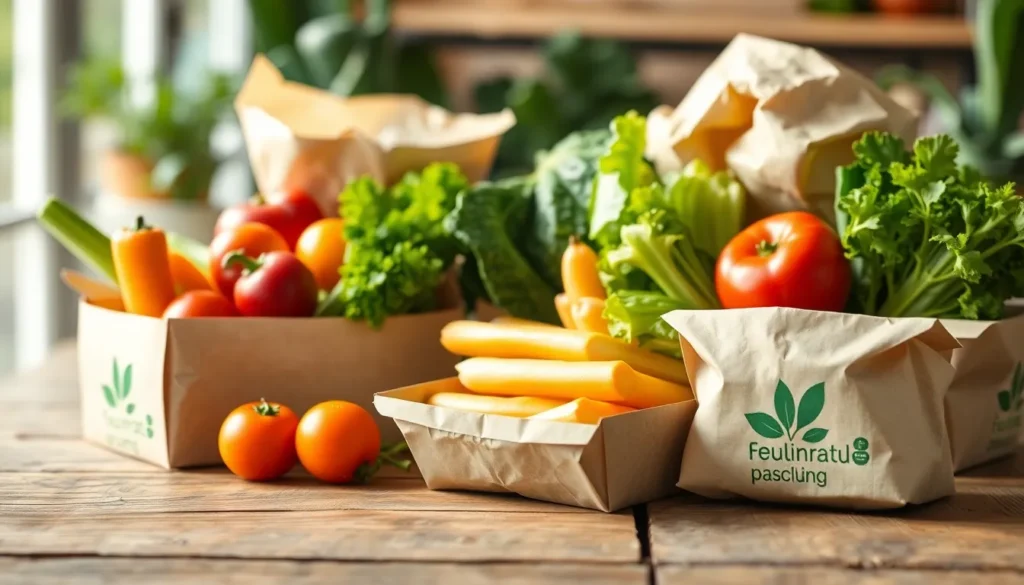In a world where first impressions matter, food packaging has become the unsung hero of the culinary experience. It’s not just about keeping food fresh anymore; it’s about making a statement. From eco-friendly materials to eye-catching designs, packaging is evolving faster than you can say “organic quinoa.”
As consumers become more conscious of their choices, brands are stepping up their game. They’re ditching the boring and embracing creativity, sustainability, and innovation. Imagine unwrapping a snack that not only tastes good but also makes you feel good about your impact on the planet.
Table of Contents
ToggleOverview Of Food Packaging Trends
The landscape of food packaging continues to evolve rapidly, reflecting a growing interest in sustainability. Creative designs now dominate the market, appealing to environmentally aware consumers. Companies prioritize eco-friendly materials, such as biodegradable and recyclable options, which reduce environmental impact. Innovative technologies improve packaging functionality, ensuring products remain fresh longer while minimizing waste.
Unique branding approaches enhance consumer engagement, with eye-catching graphics and informative labels becoming standard. Personalization trends provide tailored packaging solutions, catering to individual preferences and enhancing customer experience. Convenience also plays a crucial role, influencing designs that allow for easy use and storage.
Data from recent surveys indicates that 74% of consumers prefer packaging that highlights sustainability efforts. Packaging that clearly communicates environmental benefits resonates more with shoppers. As a result, businesses are more inclined to adopt sustainable practices, reinforcing their commitment to eco-conscious initiatives.
Moreover, the rise of online grocery shopping has redirected attention to protective yet attractive packaging. It promotes safe transport while maintaining product quality. In this shifting environment, companies that embrace these trends gain a competitive edge.
Overall, food packaging trends reflect a broader movement towards sustainability, convenience, and consumer engagement. Adapting to these trends enhances brand loyalty and establishes a stronger connection with consumers.
Sustainability In Food Packaging
Sustainability stands at the forefront of food packaging trends. Brands increasingly seek eco-friendly solutions that resonate with conscious consumers.
Biodegradable Materials
Biodegradable materials break down naturally, reducing environmental impact. Options like plant-based plastics and compostable films gain popularity in the food industry. These alternatives mitigate pollution, promoting a circular economy. For instance, companies like Nestlé and Unilever utilize biodegradable packaging, showcasing their commitment to sustainability. While effectiveness in maintaining product freshness remains crucial, the shift towards biodegradable options reflects growing consumer demands for environmentally friendly choices.
Recyclable Packaging Solutions
Recyclable packaging solutions help facilitate resource recovery and reduce landfill waste. Materials such as glass, aluminum, and specific plastics can be recycled efficiently. A significant number of consumers, 74%, prefer packaging that showcases sustainability efforts. Brands like Coca-Cola emphasize recyclability in their designs, ensuring that their products align with eco-conscious values. Improved labeling and consumer education play vital roles in promoting responsible recycling practices. These initiatives empower customers to make environmentally sound decisions while keeping packaging engaging and functional.
Innovative Packaging Technologies
Innovative packaging technologies are transforming the food industry, enhancing both functionality and sustainability. Smart packaging stands out as a leading trend.
Smart Packaging
Smart packaging integrates technology with packaging materials, providing real-time information about product status. For instance, sensors can monitor temperature and freshness, alerting consumers to potential spoilage. Many brands utilize QR codes and NFC tags, allowing consumers to access detailed product information and sustainability efforts effortlessly. As online grocery shopping grows, smart packaging adds value by ensuring product quality upon delivery, thus enhancing customer trust and engagement.
Active Packaging Solutions
Active packaging solutions actively interact with food contents to extend shelf life. For example, oxygen scavengers and moisture absorbers help maintain ideal storage conditions. This type of packaging limits spoilage and reduces waste while preserving quality. Several brands incorporate active materials like essential oils for natural antimicrobial properties, further increasing their appeal. Reports indicate that 74% of consumers prefer packaging designed with sustainability in mind, making active solutions attractive for both brands and consumers alike.
Consumer Preferences And Behaviors
Consumer preferences significantly shape food packaging trends. Eco-conscious shopping trends reveal that 74% of consumers favor packaging that highlights sustainability efforts. Awareness of environmental issues has driven shoppers toward brands utilizing biodegradable and recyclable materials. Plant-based plastics and compostable films have emerged as popular choices among eco-aware consumers. Brands that prioritize these materials tend to attract more buyers seeking responsible options.
Impact of packaging on purchasing decisions plays a crucial role in the marketplace. Eye-catching designs and informative labels engage consumers visually and intellectually. Research indicates that packaging influences over 60% of buying decisions at the point of sale. Attractive packaging can convey quality and brand values, enhancing consumer trust. Providing transparent information about sustainability efforts can significantly sway consumers toward making a purchase. As online shopping becomes more prevalent, the need for protective yet appealing packaging continues to grow, demonstrating its importance in securing consumer loyalty.
Regulatory Factors Affecting Packaging
Regulatory factors play a critical role in shaping food packaging practices. Standards set by organizations like the Food and Drug Administration (FDA) and the Environmental Protection Agency (EPA) ensure consumer safety and product integrity. Regulations surrounding food contact materials dictate what substances can be used, impacting the choice of packaging materials for manufacturers.
In recent years, laws promoting environmentally friendly practices have emerged. These laws often require companies to decrease plastic usage or transition to biodegradable alternatives. Compliance with such regulations can enhance brand reputation while aligning with consumer expectations for sustainability.
Packaging labeling requirements are also significant. Clear labeling, including nutrition facts and ingredient lists, informs consumers and helps them make educated choices. Moreover, transparency in sourcing and materials appeals to eco-conscious consumers. Research shows that 74% of consumers prefer packaging that underscores sustainability efforts; therefore, brands increasingly face pressure to meet these preferences through compliant packaging strategies.
Global agreements, such as the Paris Agreement, emphasize the need for eco-friendly solutions across industries, including food packaging. Compliance with international standards can influence local practices, driving brands to adopt sustainable packaging solutions.
Regulatory compliance may involve significant investments in technology and resources. However, companies that prioritize sustainable requirements often find competitive advantages in the market. As consumer awareness around environmental issues rises, regulations are expected to evolve, further affecting packaging trends and practices in the industry.
Future Of Food Packaging Trends
Future food packaging trends focus heavily on sustainability and innovative technologies. Companies increasingly shift towards biodegradable and recyclable materials, responding to consumer demands for eco-friendly solutions. Brands are expected to invest in smart packaging, integrating technology to provide real-time information about product freshness.
Consumer preferences continually influence the market, with 74% of shoppers favoring sustainable packaging. Research confirms that packaging significantly affects over 60% of purchasing decisions, emphasizing the need for attractive designs that communicate quality. Packaging that highlights sustainability practices wins consumer trust and loyalty.
Regulatory factors are also shaping the food packaging landscape. New laws require companies to cut plastic use and adopt biodegradable alternatives, aligning packaging practices with consumer expectations. Compliance with regulations from organizations like the FDA and EPA ensures safety while appealing to eco-conscious shoppers.
Convenience remains a priority in packaging design, driven by the rise of online grocery shopping. Protective yet visually appealing packaging ensures product quality during transport. The importance of appealing aesthetics cannot be underestimated, as it closely ties to brand perception and consumer engagement.
Innovative solutions, such as active packaging that extends shelf life, are gaining traction. Technologies that monitor temperature and freshness enhance product longevity, aligning with waste reduction goals. Brands embracing these trends not only meet consumer expectations but also strengthen their market position.
Overall, the future of food packaging trends reflects a collective focus on sustainability, technology, and consumer engagement. As consumer awareness around environmental issues increases, packaging practices must evolve in response to these shifts.
Food packaging trends are evolving rapidly as brands respond to consumer demands for sustainability and innovation. The shift towards eco-friendly materials and smart packaging solutions is not just a trend but a necessity in today’s market. Companies that prioritize these aspects are likely to enhance their brand reputation and foster consumer loyalty.
As the industry adapts to regulatory changes and rising environmental awareness, the focus on attractive and functional packaging will only intensify. This evolution reflects a broader commitment to quality and responsibility, ensuring that packaging not only protects products but also aligns with the values of conscious consumers. The future of food packaging promises to be a dynamic blend of creativity, sustainability, and technology.






